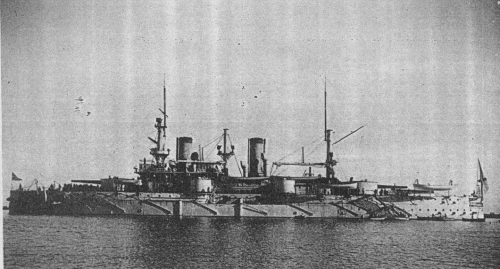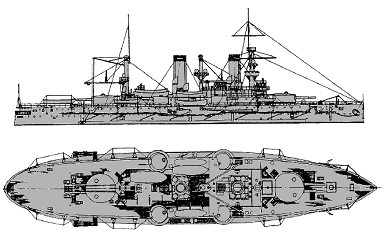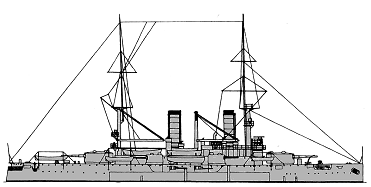
NAVYPEDIA
 Support the project with paypal
Support the project with paypal
Photo

Sevastopol 1904
Ships
| Name | No | Yard No | Builder | Laid down | Launched | Comp | Fate |
|---|---|---|---|---|---|---|---|
| Полтава [Poltava], 3.1916- Чесма [Chesma] | New Admiralty, St. Petersburg | 19.5.1892 | 6.11.1894 | 30.8.1896 | sunk 5.12.1904 (to Japan as 丹後 [Tango]), returned 6.4.1916, captured by British 3.1918, returned 21.2.1920, stricken 7.1924 | ||
| Петропавловск [Petropavlovsk] | Galernyy Is, St. Petersburg | 19.5.1892 | 9.11.1894 | 6.1897 | sunk 13.4.1904 | ||
| Севастополь [Sevastopol] | Galernyy Is, St. Petersburg | 19.5.1892 | 6.6.1895 | 1898 | demolished 2.1.1905 |
Technical data
| Displacement normal, t | 10960 |
|---|---|
| Displacement full, t | Poltava: 11500 Petropavovsk: 11354 Sevastopol: 11842 |
| Length, m | 108.7 pp 112.5 wl 114.3 oa |
| Breadth, m | 21.3 |
| Draught, m | 7.60 normal 7.90 full load |
| No of shafts | 2 |
| Machinery | Poltava, Petropavlovsk: 2 VTE, 14 cylindrical boilers Sevastopol: 2 VTE, 16 cylindrical boilers |
| Power, h. p. | 10600 |
| Max speed, kts | 16.5 |
| Fuel, t | coal 1050 |
| Endurance, nm(kts) | 3750(10) |
| Armour, mm | Poltava - Krupp steel: belt 368 - 254, bulkheads: 229 - 203, Harvey steel: main turrets 254, main barbettes: 254, secondary turrets: 127, secondary barbettes: 127, nickel steel: deck 76 - 51, CT: 229 Petropavlovsk - nickel steel: belt 406 - 305, bulkheads: 229 - 203, deck: 76 - 51, main turrets 254, main barbettes: 254, secondary turrets: 127, secondary barbettes: 127, CT: 229 Sevastopol - Harvey steel: belt 368 - 254, nickel steel: bulkheads: 229 - 203, main turrets 254, main barbettes: 254, secondary turrets: 127, secondary barbettes: 127, deck 76 - 51, CT: 229 |
| Armament | Poltava, Sevastopol: 2 x 2 - 305/38, 4 x 2 - 152/44 Canet, 4 x 1 - 152/44 Canet, 12 x 1 - 47/40 Hotchkiss, 28 x 1 - 37/20 Hotchkiss, 2 - 450 TT (sub, beam), 4 - 381 TT (aw, 1 bow, 1 stern, 2 beam), 50 mines Petropavlovsk: 2 x 2 - 305/38, 4 x 2 - 152/44 Canet, 4 x 1 - 152/44 Canet, 10 x 1 - 47/40 Hotchkiss, 28 x 1 - 37/20 Hotchkiss, 2 - 450 TT (sub, beam), 4 - 381 TT (aw, 1 bow, 1 stern, 2 beam), 50 mines |
| Complement | 631 - 652 |
Standard scale images

Poltava 1904

Chesma 1916
Graphics
Project history
First Russian battleships built in homogenous class (but with different protection). Flush deck ships with appreciable tumblehome. All main and secondary guns were installed in French-type turrets.
Ship protection Poltava
Main belt (73.2x2.29m) had 368mm thickness amidships between main gun barbettes (tapering to 184mm at lower edge) and 254mm abreast main gun barbettes inc short parts fwd from fwd and aft from aft barbettes. This belt was closed abreast main gun barbettes by 229mm fwd and 203mm aft transverse bulkheads. Upper belt (50x2.29m) between main gun barbettes had 127mm thickness and was closed by 127mm bulkheads, upper casemate between secondary barbettes had 76mm sides. Flat 51mm deck connected with upper edge of main belt. This deck had turtleback form outside citadel and had 63mm thickness near centerline and 76mm near sides. Main gun turrets had 254mm faces, sides and rears and 51mm roofs, secondary gun turrets had 127mm vertical and 25mm horizontal protection. Barbettes had 254- and 127mm sides respectively. CT had 229mm sides. Main belt was made from Krupp steel, turrets and barbettes were protected by Harvey steel, all other armour was made from nickel steel.
Ship protection Petropavlovsk
Main belt (73.2x2.29m) had 406mm thickness amidships between main gun barbettes (tapering to 203mm at lower edge) and 305mm abreast main gun barbettes inc short parts fwd from fwd and aft from aft barbettes. This belt was closed abreast main gun barbettes by 229mm fwd and 203mm aft transverse bulkheads. Upper belt (50x2.29m) between main gun barbettes had 127mm thickness and was closed by 127mm bulkheads, upper casemate between secondary barbettes had 76mm sides. Flat 51mm deck connected with upper edge of main belt. This deck had turtleback form outside citadel and had 63mm thickness near centerline and 76mm near sides. Main gun turrets had 254mm faces, sides and rears and 51mm roofs, secondary gun turrets had 127mm vertical and 25mm horizontal protection. Barbettes had 254- and 127mm sides respectively. CT had 229mm sides. Armour was made from nickel steel
Ship protection Sevastopol
Main belt (73.2x2.29m) had 368mm thickness amidships between main gun barbettes (tapering to 184mm at lower edge) and 254mm abreast main gun barbettes inc short parts fwd from fwd and aft from aft barbettes. This belt was closed abreast main gun barbettes by 229mm fwd and 203mm aft transverse bulkheads. Upper belt (50x2.29m) between main gun barbettes had 127mm thickness and was closed by 127mm bulkheads, upper casemate between secondary barbettes had 76mm sides. Flat 51mm deck connected with upper edge of main belt. This deck had turtleback form outside citadel and had 63mm thickness near centerline and 76mm near sides. Main gun turrets had 254mm faces, sides and rears and 51mm roofs, secondary gun turrets had 127mm vertical and 25mm horizontal protection. Barbettes had 254- and 127mm sides respectively. CT had 229mm sides. Main belt was made from Harvey steel, all other armour was made from Nickel steel.
Modernizations 3.
1916, Chesma (as rebuilt by Japanese): boilers were replaced by 16 Miyabara; - 12 x 1 - 47/40, 28 x 1 - 37/20, 2 - 450 TT; + 6 x 1 - 76/40 41-shiki
Naval service
Poltava was sunk on shallow water by Japanese coastal guns 5.12.1904 at Port Arthur and completely demolished by own crew 2.1.1905. Later she was salvaged, repaired by Japanese and commissioned them as Tango in 1908. Tango was purchased by Russian government early 1916 and commissioned 6.4.1916 as Чесма [Chesma]. Chesma was captured by British troops in March 1918 and transferred them to White Army but captured by Red Army 21.2.1920 and commissioned in March. Chesma was used as training hulk from June 1921 and eventually stricken 3.7.1924. Petropavlovsk was sunk by Japanese mine. Sevastopol was badly damaged 16.12.1904 by 3 torpedoes from Japanese torpedo boats and ran ashore, she was exploded by own crew 2.1.1905 to avoid capture by Japanese.
 HOME
HOME FIGHTING SHIPS OF THE WORLD
FIGHTING SHIPS OF THE WORLD RUSSIA / USSR
RUSSIA / USSR CAPITAL SHIPS AND MONITORS
CAPITAL SHIPS AND MONITORS POLTAVA battleships (1896 - 1898)
POLTAVA battleships (1896 - 1898)

